According review of the legendary Soviet lens Helios-40-2 1.5 / 85 many thanks Alexander pamp Neborachko.

Helios 40-2 85mm F1.5 lens overview
In my vote on best soviet portrait lensHelios-40-2 is the undisputed leader, while having a huge margin. The second place is held by the most massive fixed-telephoto Jupiter-37A, and the sharpest outrageous closes the top three Kaleinar-5N... Therefore, without further ado - Helios-40-2 is ideal for portrait photography.
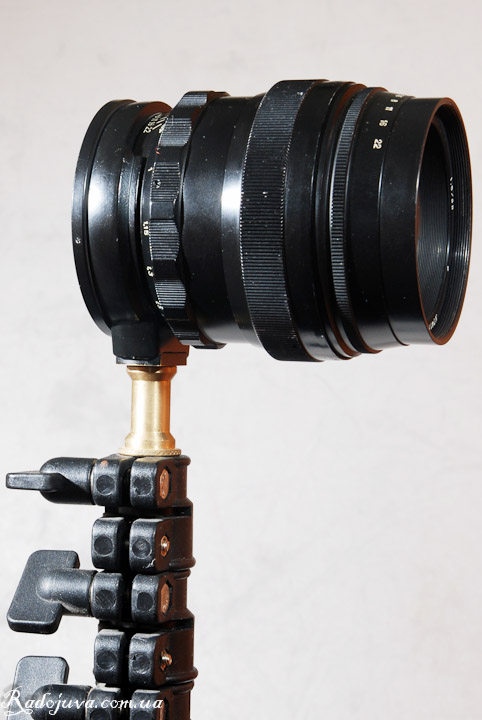
Helios-40-2 has a tripod socket and black color
TTX Helios-40-2
The weight: about 900g
MDF: 0.8m
Focal length: 85mm
Front Filter Diameter: 67mm
Factory manufacturer: Krasnogorsk Mechanical Plant named after S.A. Zvereva
Aperture Limits: F1.5-F22
Number of aperture blades: 10
Optical design: 6 elements in 4 groups, Biotar scheme
Resolution: 36/17 lines / mm (center / edge)
There are lens modifications, in particular, the differences may relate to the diameter of the filter and the minimum focusing distance. Also, there is an earlier “white version” of the lens called simply Helios-40. Read about the differences below.
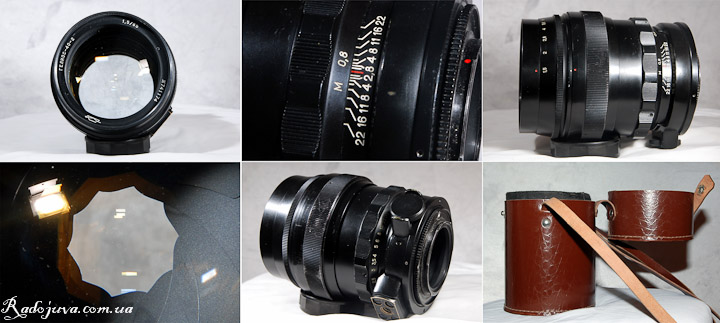
View Helios-40-2 from different sides. Case for Helios-40-2 and aperture view.
I strongly recommend that you read the materials on Helios-40 (2) on club.foto.ru, namely in the section about Helios-40 (2). I also advise you to take a look at Helios-40 review by Sergey Elizarovthat has a wonderful comparison of Helios-40 (2) and its ancestor Carl Zeiss Jena Biotar 1,5 / 75. Fans of rigorous technical tests will love the article. photozone.de about Helios-40-2. Interesting conclusions, near which you simply can’t pass by, on the page Myths and Reality Helios-40 (2)... Another brand new head-to-head test Helios-40-2 and Carl Zeiss Planar 85 / 1.4 c / y on Dmitry Evtifeev's blog... Below, in fact, about the lens from Radozhiva.
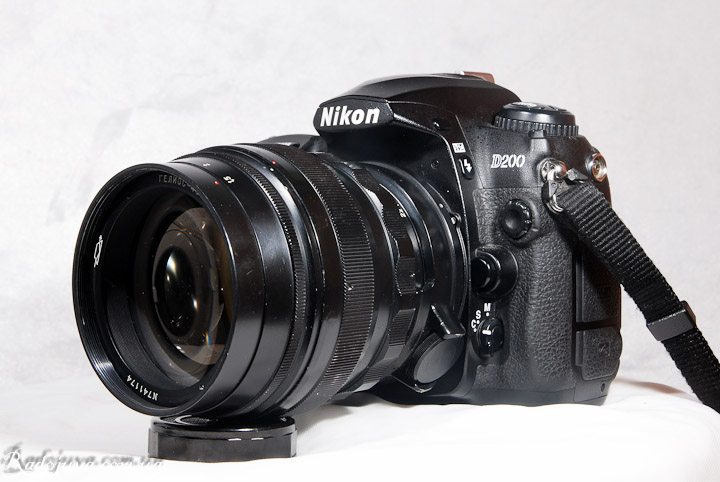
View of the Helios-40-2 lens on a modern central control wheel
Helios-40 and Helios-40-2 is a modification of the lens Carl Zeiss Jena Biotar 1,5 / 75. Helios has a slightly longer focal length. The optical design is the same - 6 lenses in 4 groups. Helios-40-2 classic Planar (Biotar). Please note that in this review in my hands was exactly Helios-40-2 and I write about him. My copy of MDF has 80cm, and the filter diameter is 67mm, its number is No. 741174. If you take into account the fact that the first two digits in the number of the Soviet lens usually indicate the year of manufacture, then my Helios-40-2 is much older than me and was released in 1974. The lens barrel is slightly frayed, but the lens is in good condition, without scuffs and scratches, enlightenment is in place.
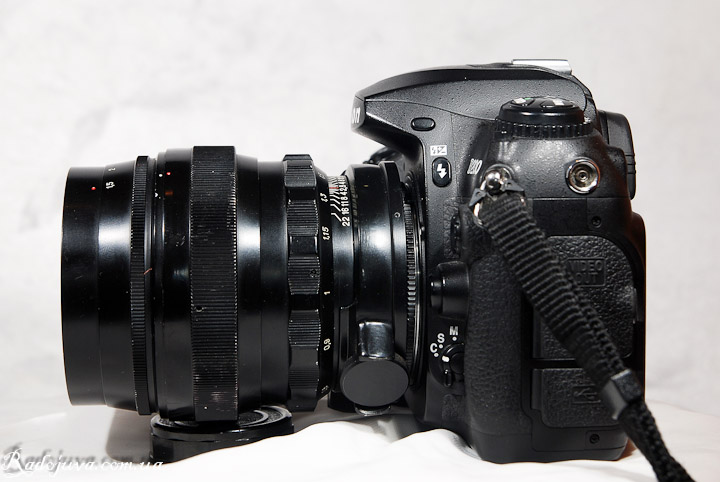
View of the Helios-40-2 lens from the side on a modern central control gear
The main modifications of the Helios-40 lens (2)
- Helios-40 1.5/85 for SLR cameras. Old white version without coloring. Uses M39 × 1/45,2 mounting thread.
- Helios-40T 1: 1,5 F = 8,5cm - option for television cameras. G-40T differs from the regular version of the G-40 by aperture control and camera mount. Helios-40T has only one diaphragm ring. The optical design of Helios-40T is the same. In any case, it will be necessary to saw off the back for installation on a modern digital SLR camera. When you close the diaphragm on the G-40T lens, in the blur zone, you get the same "circular" saw, like his brother G-40. Produced at KMZ (Krasnogorsk Mechanical Plant named after S.A. Zverev, Krasnogorsk.)
- Helios-40-2 1.5/85 for SLR cameras, has a M42 × 1 / 45,5 mounting thread. The main difference from Helios-40 is only in the landing thread, body color and tripod socket. The Helios-40-2 version itself also has options with minor differences. For example, there are options with a 66 mm filter and 1.15 m MDF.
- Cyclops 1.5 / 85 (Aka CYCLOP 1,5/85) for night vision device. The main difference is the different frame and the complete absence of a diaphragm. Perhaps Cyclops has a different enlightenment. There is also a version with the name in Latin 'Cyclop 1.5 / 85'. The lens was produced at ROMZ (Rostov Optical and Mechanical Plant). Overview here.
- New Helios-40-2issued by KMZ in 2012 year. There is a modification Helios-40-2-N 1,5 / 85 or HELIOS-40-2-N 1,5 / 85 under Nikon F and Helios-40-2-C 1,5 / 85 or HELIOS-40-2-C 1,5 / 85 for Canon EOS and HELIOS-40-2 1,5 / 85 for M42 thread. Since 2014, it has a new body design and double-layer coating, without a tripod foot.
- HELIOS-40 F = 8,5cm 1: 1.5 - lens prototype for cameras with bayonet mount Contax-Kiev (the lens came with an external mount). 1950-1951, MDF 1 meter, looks like this.
- Meyer Optik Görlitz Somnium 1:1.5/85mm (2015) - rebranded and repainted Helios-40-2 2012
- Meyer-Optik Gorlitz Biotar 75mm f/1.5 II (2023) – modern Carl Zeiss Jena Biotar 1,5/75
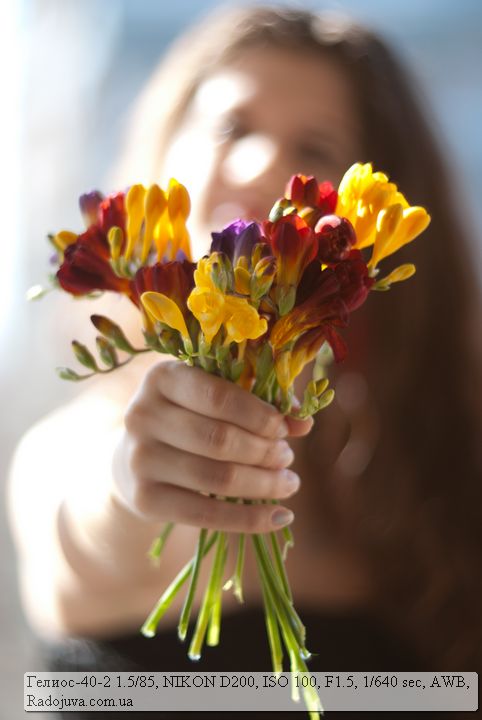
Background blur on Helios-40-2
Myths about Helios-40 (2)
- The first myth is the opinion that Helios-40 was copied from some very ancient and not popular lens. Often give an example Leica Summarex 1,5 / 85 or Cyclops 1.5 / 85, produced at the Rostov optical-mechanical plant. Summarex is a real myth. Regarding Cyclops, everything is just the opposite, Cyclops was a copy of Helios-40 without a diaphragm. Many photos on Cyclops can be found here.
- There is an opinion that the aperture of the lens is actually not F / 1.5, but F / 1.3, motivate this by the fact that according to GOST there was no value of 1.3, therefore they wrote 1.5. Thus, the lens is credited with a much larger aperture.
- There is a myth that with the help of Helios-40 anyone can take a gorgeous portrait. It's a delusion. The lens is very difficult to work with. Achieving good image quality with the right focus point and the right composition will take some hard work. This is due to the fact that Helios-40-2 is sharp at F1.5 only in the center, and the depth of field is very shallow. Only a person with experience in manual optics can cope with Helios-40-2.
- There is a myth that one photographer in his entire life tried the very latest very expensive photo equipment, super modern digital backs, switched from a full frame to a medium and large format, but never found the lens that would give an image that would give an image that he wanted to receive. As a result, he accidentally stumbled upon Helios-40 and discovered the full power of the “Solar” lens, with which he began to create masterpieces. Perhaps this is not a myth. But personally, my opinion is that this is a fallacy, since every photographer who is less self-respecting understands that it is he who shoots, and not the technique, because important how to take pictures, and not by any means. If you are chasing an “interesting” technique, then you can miss the very opportunity to shoot, and sometimes miss your whole life.
- A lot of various information on the Internet and beautiful photos. The myth is that almost all photos come with quite serious processing, at least with an auto contrast or b / w, which does not show a real Helios-40-2 picture. In reality, the raw picture from Helios-40-2 does not look as interesting as after processing. Therefore, just keep this in mind when choosing between Helios and another lens.
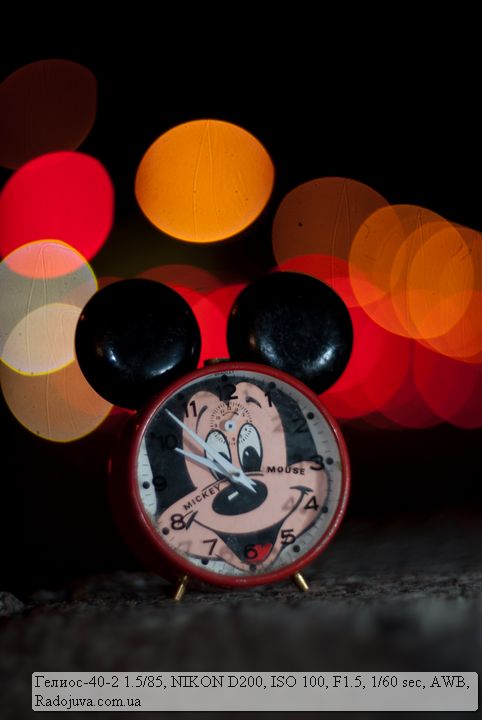
Bokeh on Helios-40-2 85mm F1.5
The main features of the Helios-40-2 lens:
1. In the Helios-40-2 lens design, almost everything is made of metal and glass. The lens is older than me, and continues to please with its work. This is a serious indicator of excellent build quality.
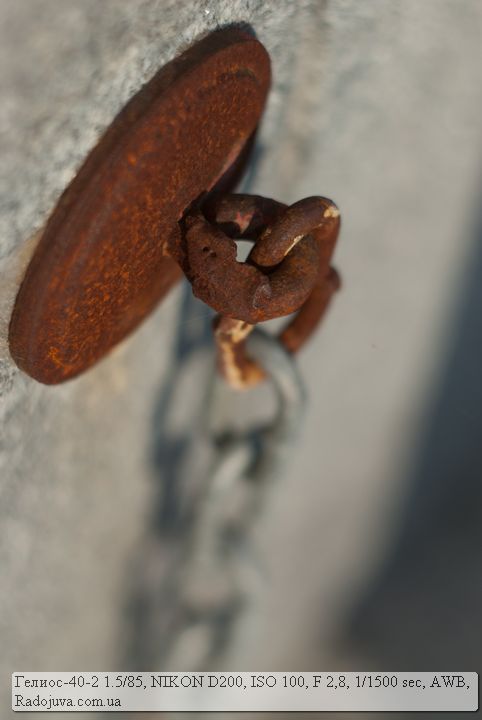
Photo on Helios 40-2 85mm
2. The lens is very large aperture for such a focal length. The maximum aperture value is F1.5. This is only 1.15 times less than the classic F1.4 value for portrait lenses with 85mm focal length. The difference between F1.5 and cheap 85mm fixes with F1.8 is exactly 1.44 times. Big aperture Great for shooting in low light. Possible evening take off not afraid for grease.
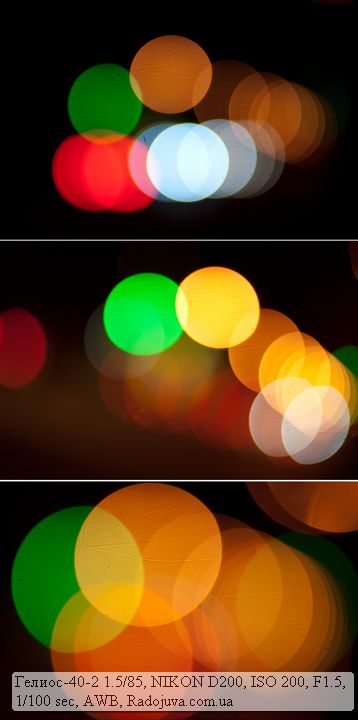
Bokeh on Helios-40-2 85mm F1.5
3. A focal length of 85mm on a Canon 1.6x crop gives EGF at 136mm. For Nikon crop with 1.5x EGF will be 127,5mm. On the crop, Helios-40-2 also remains an excellent portrait painter. The lens can and should be used at full frame, unlike Nikon DX or Canon EF-S lenses.
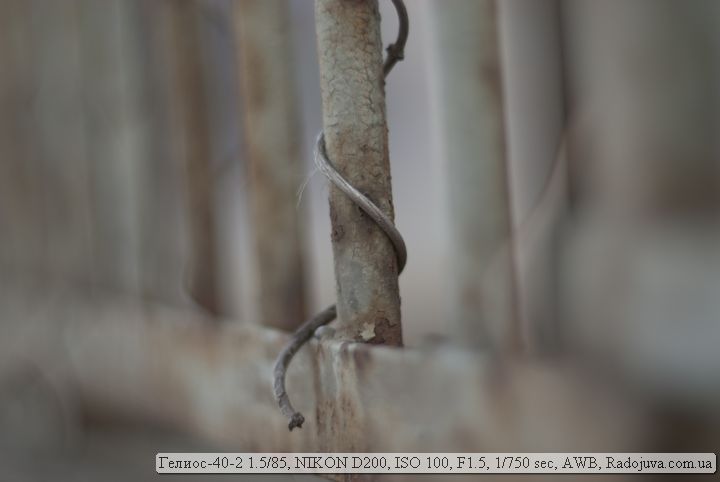
Photo on Helios-40-2 85mm F1.5
4. The lens has an additional aperture presetting ring. The aperture ring itself is located in front of the lens, and the preset ring is in the middle. Moreover, the pre-installation is very convenient, since its ring has a large grip. This is one of the few lenses where the aperture presetting ring is really handy. At the same time, the lens does not have a semiautomatic iris control (it does not have a diaphragm pusher for cameras).
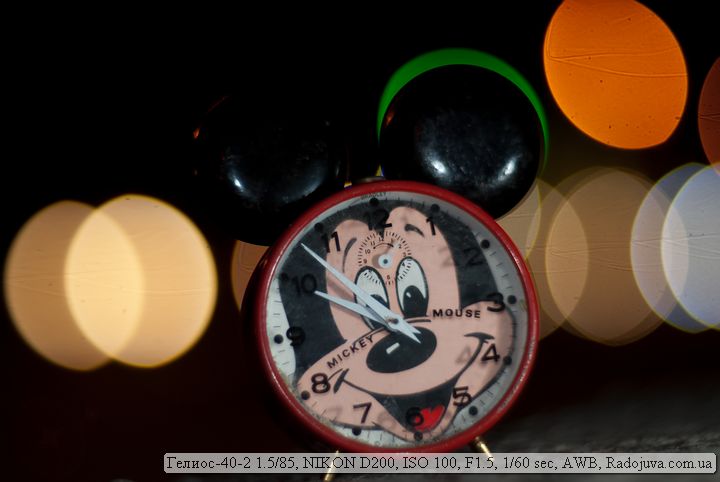
Bokeh on Helios-40-2 85mm F1.5
5. The focus ring has a smooth ride. A serious drawback of Helios-40-2 is the fact that the focusing ring is set too close to the camera mount. It is not very convenient to twist it. And even worse, the tripod socket clamp, which is located even closer to the bayonet, interferes with focusing. First, instead of focusing on focus, you twist the largest ring out of habit - the aperture preset ring. It's a little unnerving, but you get used to it over time. The focus ring is nut-like, not flat.
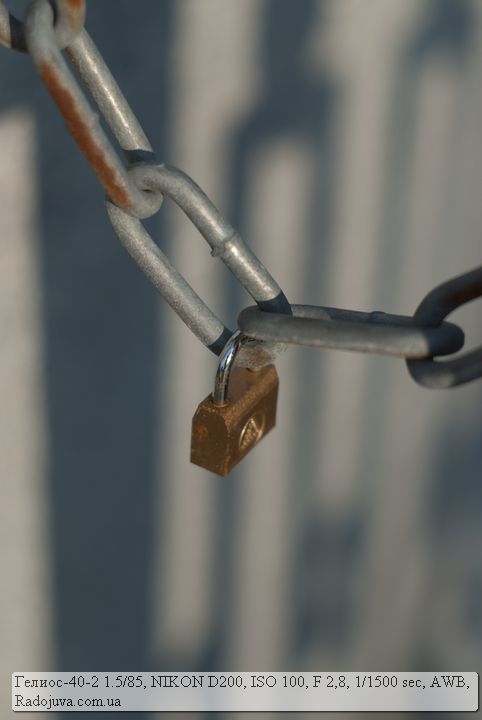
Photo on Helios-40-2
6. Helios-40-2 has a tripod socket. This suggests that the lens is really heavy, the clamp is near the mount to the camera. The clamp can rotate 360 degrees on the lens and is fixed with a special lock, which twists and clamps the clamp. Tripod socket is standard.
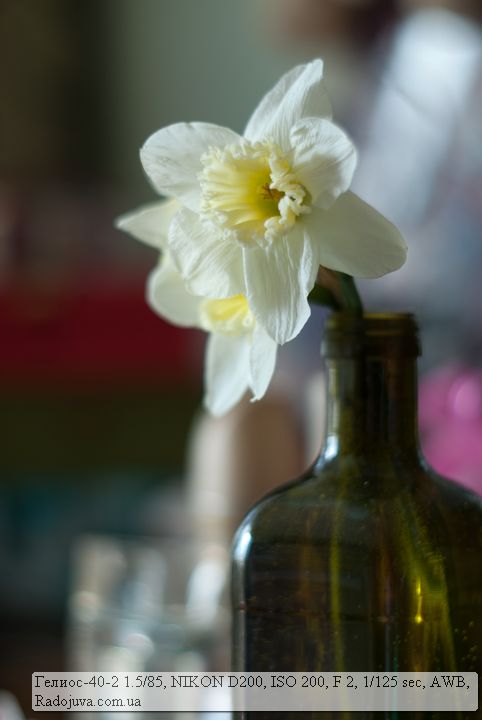
Sample photo on Helios-40-2
7. The lens Helios-40-2 10-blade aperture... The number of petals is more than average, but when it is closed, a hole is formed that looks like a circular saw. Luminous points in the out-of-focus area on closed diaphragms turn into a “circular” pattern. The lenses Tair-11A, Jupiter-37A, Jupiter-11, Jupiter-9 have even more petals and they form a fairly even hole without nuts and gears, therefore, they are more suitable as a portrait lens with closed diaphragms. Helios-40-2 is saved only by the fact that it gives the most interesting (from an artistic point of view) picture on a fully open aperture F1.5. Below is an example of a photo with circular saw blades in the out-of-focus area.
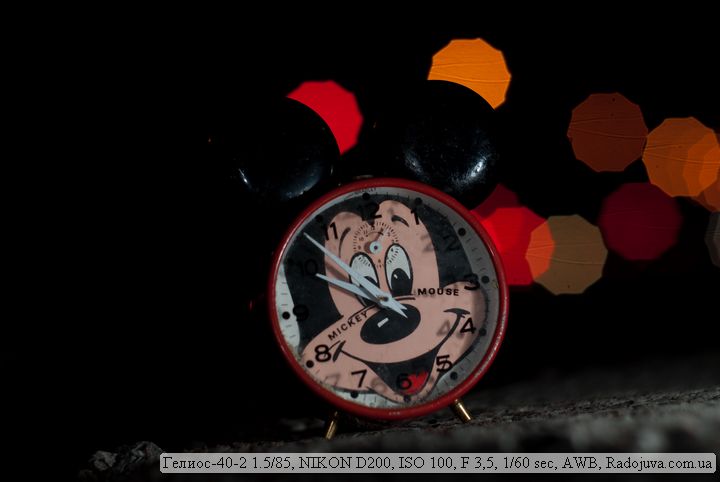
Bokeh on Helios-40-2 85mm F1.5 on aperture F3.5
8. The lens is quite heavy. On amateur lungs of TsZK's there can be a problem with weight balance. I think the same problem was when shooting on film Zeniths. On my kilogram Nikon D200 Helios-40-2 lens sits like a native, without causing inconvenience. Due to the large grip of the handle D200 very easy to control with Helios-40-2. I often have to shoot on a camera heavier in weight than one D200 + Helios-40-2. The weight of the lens and camera avoids movement when shooting handheld at slow shutter speeds.
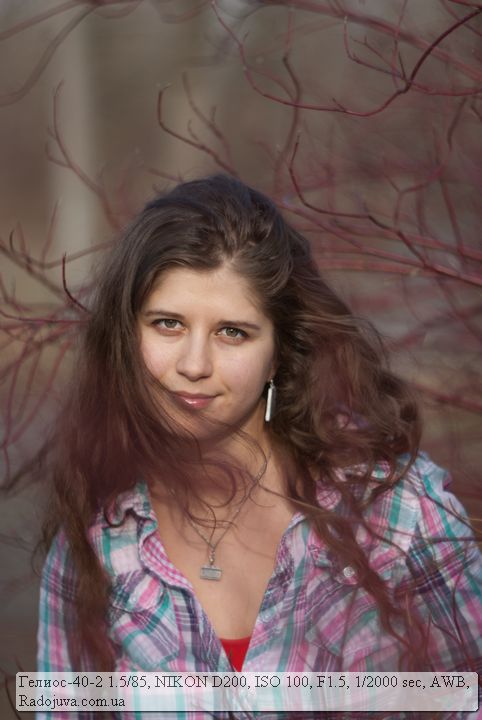
Portrait on Helios-40-2
9. The lens has enlightenment. I have never found reliable information about whether it is MS or not MS. The color of enlightenment is yellow.
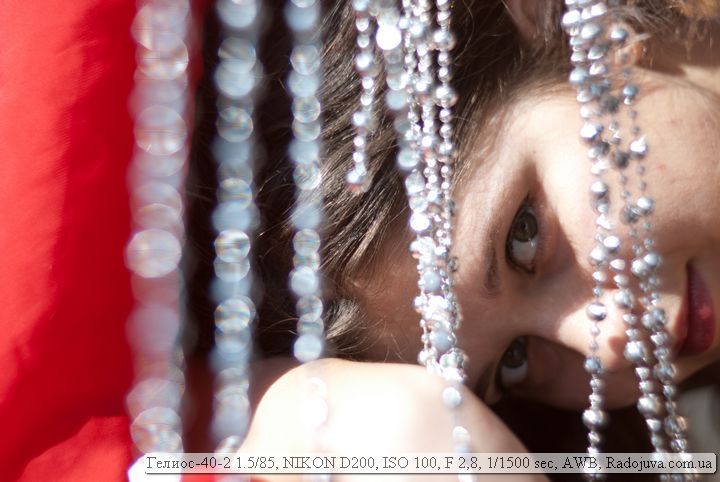
Example photo on a Helios 40-2 lens
Sample photos on Helios-40-2
All sample photos in the review without processing. Convert from RAW to JPEG with Q80% quality (without auto levels, etc.), reduced the size to 1600 * 1200 and imprinted data from EXIF. All sample photos were taken on Nikon D200 (crop factor matrices 1.5x). On my D200 the function key is configured to change the parameters of manual optics, therefore, it is very convenient to close the aperture to any value and immediately make adjustments to EXIF. Only, D200 allows you to set the minimum aperture only for values F1.2, F1.4, F1.8.
UPDATE 1
Examples of photos on HELIOS-40-2-N 1,5 / 85 and the camera Nikon D600 with readers of Radozhiva shared photographer Nelya Rachkova:
UPDATE 2
Examples of photos on HELIOS-40-2 1,5 / 85 (This one) with readers of Radozhiva shared photographer Igor Kurilov.
Each system has its own lens icons - these are lenses that people pray for and want to get. For Nikon, it's Nikon N AF-S Nikkor 85mm 1: 1.4G, for Canon is Canon LENS EF 85mm 1: 1.2 L II USM, and for Soviet Optics - this is Helios-40-2. This is a logical explanation, since the idol should always be.
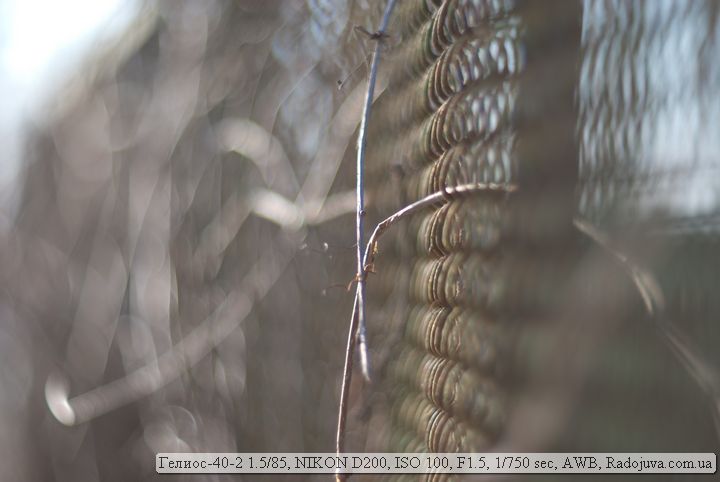
Example photo on a Helios-40-2 lens in strong lateral light
To buy or not to buy Helios-40 (2)?
If you ask such a question, then do not buy. People to whom it will really be useful know for themselves this and it will not be difficult for them to pay a tidy sum for the lens. I absolutely do not recommend Helios-40-2 to beginners who are looking for an addition to the whale lens. The best option for using the lens is in full frame. A full frame is not so cheap, people who shoot it have experience and will be able to get what they need out of Helios-40-2.
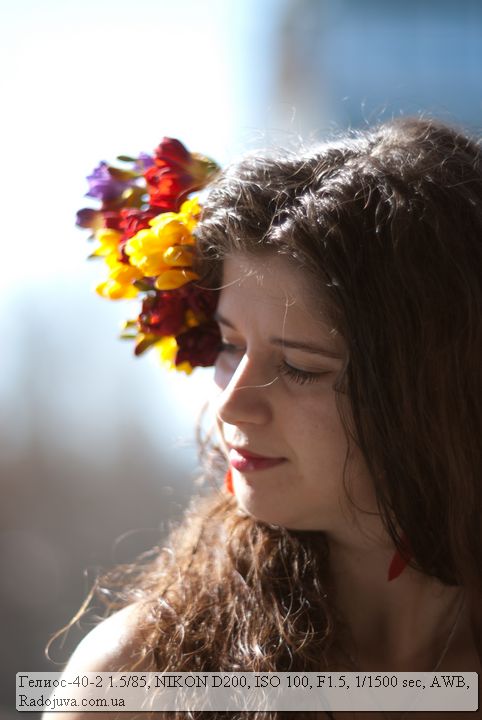
Portrait on Helios 40-2 in strong lateral light
Alternatives
By alternatives, I mean autofocus lenses with similar parameters. If you are looking for an alternative lens, there are many other options. From Soviet-like lenses, I recommend looking at white version of Jupiter-9 85mm F2.0... Jupiter-9 is an excellent portrait lens, it will be enough for a classic portrait. Slightly longer and much darker - medium format MS Vega-28V 2.8 / 120, which allows you to shoot gorgeous portraits. Another great alternative may be a relatively new and very high quality Samyang AE 85mm 1: 1.4 AS IF UMC (And
From the native optics for Nikon, you can look at the classic manual lenses Nikon Nikkor 85mm 1: 1.4 AI-S, Nikon Nikkor 85mm 1: 1.8 (and its many modifications) and Nikon Nikkor 85mm 1: 2. It is quite interesting that all these lenses have better sharpness and contrast characteristics throughout the field of the frame, but they are much less popular than Helios-40-2. Carl Zeiss Planar T * 1.4 / 85 and older Carl Zeiss Planar 1.4 / 85 C / Y options can also be an alternative. From modern autofocus optics, there are many options, but we are talking specifically about manual lenses with manual focus.
All autofocus 85s
Choosing a good 85mm portrait lens is very important for a large number of photographers. I pay a lot of attention to this issue, therefore I have prepared this list of all such autofocus lenses for full frame cameras with F <= 2 and a focal length of about 85 mm.
Nikon (F, Z mounts)
- Nikon 85mm 1: 1.8 AF Nikkor [December 1987]
- Nikon 85mm 1: 1.8D AF Nikkor [March 1994, Thailand/Japan]
- Nikon 85mm 1: 1.4D AF Nikkor [November 1995]
- Nikon 85mm 1: 1.4GN AF-S Nikkor SWM IF Nano Crystal Coat [August 2010]
- Nikon 85mm 1: 1.8G AF-S IF SWM Nikkor [January 2012]
- Nikon Nikkor Z 85mm 1: 1.8 S [July 2019]
- Nikon Nikkor Z 85mm 1: 1.2 S [January 2023]
Canon (EF, RF mounts)
- Canon LENS EF 85mm 1:1.2 L USM [September 1989
- Canon LENS EF 85mm 1: 1.8 USM [July 1992]
- Canon LENS EF 85mm 1:1.2 L II USM [March 2006]
- Canon LENS EF 85mm 1:1.4 L IS USM [November 2017]
- Canon lens RF 85mm F1.2L USM [May 2019]
- Canon lens RF 85mm F1.2L USM DS (DEFOCUS SMOOTHING) [October 2019]
Yongnuo/YnLens (different mounts)
- Yongnuo YN85mm F1.8 (YN85mm F1.8) [9/6, Canon EF, February 2017]
- Yongnuo YN85mm F1.8 (YN85mm F1.8N) [9/6, Nikon F, May 2019]
- Ynlens YN85mm F1.8S DF DSM (YN85mm F1.8S) [9/8, Sony E, August 2020]
- Ynlens YN85mm F1.8R DF DSM (YN85mm F1.8R) [9/8, Canon RF, May 2021]
- Ynlens YN85mm 1:1.8Z DF DSM (YN85mm F1.8Z) [9/8, Nikon Z, March 2022]
- Yongnuo 85F1.8S DF DSM [9/8, Sony E, August 2022]
Sony / Sony Zeiss ZA / Minolta (E / FE, A mount)
- Sony FE 1.4/85 GM (SEL85F18GM) [February 2016]
- Sony FE 1.8/85 (SEL85F18) [February 2017]
- Sony SAL85F14Z / Carl Zeiss Planar 1,4 / 85 ZA T* [June 2006]
- Minolta AF 85mm 1:1.4 (22) (AF lens 85) / Minolta Maxxum / Dynax / G / G+D / G+RS / G+D+LE and other versions of the same lens, A mount [1987]
Sigma (different mounts)
- Sigma EX 85mm 1: 1.4 DG HSM (two sub-versions with different body finishes, for Canon EF, Nikon F, Pentax K, Sony A, February 2010)
- Sigma 85mm 1: 1.4 DG | A [Art] (for Canon EF, Nikon F, Sigma SA, Sony E, Leica L, September 2016)
- Sigma 85mm 1: 1.4 DG DN | A [Art] (for Sony E, Leica L, August 2020)
Viltrox (different mounts)
- Viltrox PFU RBMH 85mm F1.8 STM (Sony E/FE + Fujifilm X, 2018)
- Viltrox AF 85/1.8 STM ED IF (Nikon Z, Canon RF, December 2020)
- Viltrox AF 85/1.8 II STM ED IF (Sony E/FE + Fujifilm X, July 2020, light version XNUMX)
Pentax (K mount)
- SMC Pentax-FA* 1:1.4 85mm IF AUTO FOCUS PENTAX 85 [1992]
- HD PENTAX-D FA * 85mm 1: 1.4 ED SDM AW [May 2020]
Samyang / Rokinon (different mounts)
- Samyang AF 85 / 1.4 EF (for Canon EF, scheme 9/7, June 2018)
- Samyang AF 85/1.4F (for Nikon F, scheme 9/7, April 2019)
- Samyang AF 85 / 1.4 FE (for Sony E, scheme 11/8, March 2019)
- Samyang AF 85 / 1.4 RF (for Canon RF, scheme 11/8, May 2020)
- Samyang AF 85 / 1.4 FE II (for Sony E, scheme 11/8, July 2022)
Meike (Canon EF, Nikon F, Sony E, Nikon Z, FujiFilm X)
- MEIKE 85mm AF 1: 1.8 [review] (Canon EF / Canon EF-S, April 2018)
- MEIKE 85mm AF 1: 1.8 [review] (Nikon F, Aug 2020)
- MEIKE 85mm 1:1.8 Auto Focus Lens FF STM [review] (for Sony FE/E + Nikon Z, Canon RF, FujiFilm X, June 2022 + March 2023)
- MEIKE 85mm 1:1.4 Auto Focus Lens FF STM (for Sony FE/E + Nikon Z, September 2023)
Zeiss (various mounts)
- Zeiss Sonnar 1.8 / 85 T * (Batis 1.8 / 85) [April 2015, built-in stabilizer, Sony E/FE mount, 11/8]
- Carl Zeiss Planar 1,4/85 ZA T* (Sony SAL85F14Z) [June 2006, Sony A/Minolta A mount, 8/7]
- Carl Zeiss Planar 1,4 / 85 T * [November 2002, Contax N mount, 10/9]
Tamron (different mounts)
- Tamron SP 85mm F/1.8 Di VC USD Model F016 (for Canon EF, Nikon F, Sony A [without VC function], March 2016)
Tokina (Sony E / FE mount)
- Tokina atx-m 85mm F1.8 FE (for Sony E, most likely a complete analog Viltrox PFU RBMH 85mm F1.8 STM, January 2020)
AstrHori (Sony E/FE mount)
-
AstrHori AF 85mm 1:1.8 [December 2022]
Panasonic (L mount)
- Panasonic LUMIX S 1: 1.8 / 85mm [November 2020]
Separately, you can still highlight non-classic 85s:
- macro lens Canon Lens RF 85mm F2 MACRO IS STM [2020, RF]
- longer LEICA APO-SUMMICRON-SL 1: 2/90 ASPH. (2018, Leica l)
- less aperture Sony 85 / 2.8 SAM (SAL85f28) [2010, A]
- shorter SMC PENTAX FA 1:1.8 77mm Limited (1997, K)
- shorter HD Pentax-FA 1: 1.8 77mm Limited (2021, K)
- shorter Samyang AF 75 / 1.8 FE (2020, E) + Samyang AF 75/1.8X (2023, X)
- cropped Samsung Lens 1:1.4 85mm ED SSA i-Function [2011, NX]
- cropped and longer FUJIFILM FUJINON LENS SUPER EBC XF 90mm 1: 2 R LM WR [2015, X]
- cropped and shorter Viltrox AF 75/1.2 XF STM ED IF [2022, X, E, Z]
- cropped, less aperture, macro lens Nikon DX AF-S Micro Nikkor 85mm 1: 3.5G ED VR SWM IF Micro 1: 1 [2009, F]
- many 90/2.8 class macro lenses
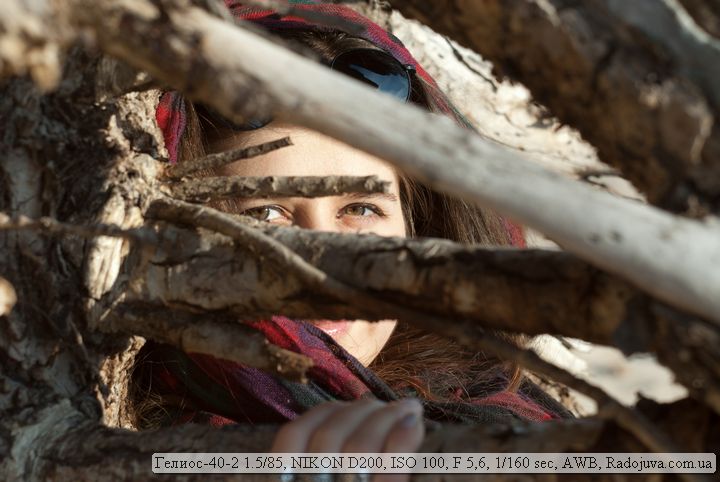
Example photo on Helios 40-2
Image quality on Helios-40-2
Under the image quality of Helios-40-2, some people mean its artistry, and another means its technical perfection. The artistry of the image produced by the lens is very interesting, with a special character. From the technical point of view, the Helios-40-2 lens has a slight vignetting, in the region of 1/3 stop at the corners of the cropped matrix. The vignette is almost invisible to the eye. Lens sharpness differs greatly around the edges and in the center of the frame. In the center of the frame, sharpness is excellent already at F1.5, sharpness at the edges starts at F2.8. Helios-40-2 has an interesting sharpness curve. Loss of sharpness from the center is a characteristic feature of the lens. Wide aperture is sharp enough to create a portrait. It is very interesting that HA (chromatic aberrations) in Helios-40-2 are very low. I was surprised that already at F2.0 Ha completely disappear. For example, Nikon AF Nikkor 85mm f / 1.8D is losing HA only at aperture F4.0. Such an excellent indicator HA on F2.0 there are units of lenses, for example, Nikon 85mm F1.4D etc. Like any other 85mm fast-fix, Helios-40-2 has minimal distortion, which avoids image distortion. On open diaphragms, Helios-40-2 gives light spherical aberrations (blurring of contours) that make the picture airy (see section monocle). The contrast of the lens at wide apertures is not very good. The lens is afraid of side and backlight. Color rendering is slightly lukewarm, but automatic white balance modern cameras can handle this easily. And, of course, bokeh is the fad of the lens. In the out-of-focus area, a motley swirling background is obtained. The circles of confusion are slightly compressed, like ellipses. Most of all, the background of the lens rotates at a fully open aperture at the edges of the frame.
It so happened that all the advantages and disadvantages are collected in Helios-40-2 in an unusual way and make it really a lens with character. In particular, Helios-40-2 is impeccable for creating portraits where smoothness, volumetricity and strong sharpness are not needed (especially for a female portrait).
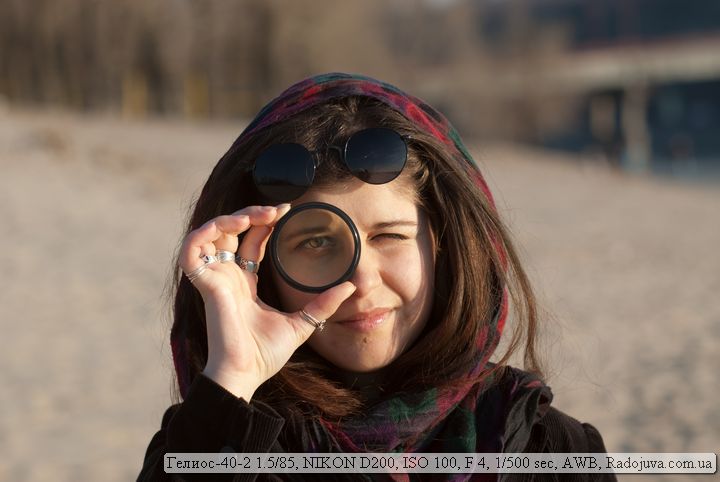
Photo at Helios 40-2
Personal impressions
I liked the lens. I only focused on the green dot in my viewfinder Nikon D200... Aiming is rather difficult, but my experience with manual optics helped me. I highly recommend everyone to use Live View for focusing. Personally, I like the fact that people are trying to squeeze the maximum quality out of the Helios-40-2 with mediocre MTF - this makes you photograph and train your dexterity, and not just press the shutter button. Since I do not have a full-frame camera, it is difficult for me to judge in full. I personally use a lightweight autofocus lens. Nikon AF Nikkor 85mm f / 1.8D, which many have forgotten, but which gives a predictable result. There are many discussions on the Internet about the quality of photographs taken with the Helios-40-2 lens - note that we can only talk about this or that actual copy, since the technique is quite old and many judge by the unsuccessful version of Helios-40-2, many simply never did not hold it in their hands. Also, there are a lot of discussions about its cost - in fact, in order to purchase Helios-40-2, it is enough to shoot 1-2 weddings or several photo sessions, so professionals should not have any problems with this. Amateurs, however, will not always be able to squeeze out all its potential from Helios-40-2 and realize a scene in which the Helios-40-2 lens will be a useful tool for creating photography.

Photo on Helios-40-2
Prices
Now they are selling an updated version of this lens. You can see the real prices for the lens from online stores at this link.
How to use with modern cameras?
Lenses with mounting thread M42 (M42 X 1 / 45.5), such as the lens from this review, are very easy to use on almost any modern digital camera (both SLR and mirrorless), for this it is enough to choose the right adapter (adapter). You do not need to carry out any additional steps to modify the lens.
The cheapest adapters can be found at Aliexpress.com... There are adapters (adapters) with a chip that provide more convenience during shooting, usually chips are used to confirm focus and / or metering exposure, and form the correct EXIF. The chip does not affect the image quality in any way.
For some SLR cameras (for example, with the Nikon F-mount), you need to use adapters with a corrective lens, which allows you to focus correctly at all focusing distances. For any mirrorless cameras, such a lens is not needed, and the adapter is a simple decorated hollow metal tube with an appropriate mount.
For SLR cameras
- Canon: For cameras Canon EOS with bayonet mount EF / EF-S need an M42-Canon EOS adapter, such an adapter with a chip can be found herewithout chip here.
- NIKON: For cameras Nikon DX / FXas well as for cameras Fujifilm и Kodak with a Nikon F mount, you need an M42-Nikon F adapter, you can buy such an adapter without a lens and a chip here, with a lens without a chip herewith chip without lens here, with lens and chip here. Why a lens? Why chip?
- PENTAX: For Pentax cameras with K mount, you need an M42-Pentax K adapter, you can buy such an adapter here.
- SONY/MINOLTA: For cameras with a Sony / Minolta A mount, you need the M42-Sony A adapter, you can find such an adapter without a chip at this linkwith a chip at this link.
- OLYMPUS/PANASONIC/LEICA: For cameras with a 4/3 bayonet mount (not to be confused with Micro 4/3!) You need an M42-4 / 3 adapter, you can buy such an adapter here.
For mirrorless cameras
- SONY: For cameras with 'E'/'FE' mount series SonyNEX и Sony Alpha you need an adapter M42-Sony E (aka M42-Sony Nex), you can find it at this link. An autofocus adapter is also available for these cameras. Techart PRO Leica M - Sony E Autofocus Adapterwhich can be found at this link.
- OLYMPUS / PANASONIC / KODAK / XIAOMI: For cameras with a bayonet mount Micro 4/3 (Micro 4:3) you need an adapter M42-Micro 4/3, you can find it at this link.
- CANON M: For cameras with Canon EF-M mount need adapter M42-Canon M, it can be found at this link.
- CANON R and RF-S: For cameras with Canon RF mount need adapter M42-Canon R, it can be found at this link.
- Nikon 1: For cameras Nikon 1 Series need adapter M42-Nikon 1, you can find it at this link.
- Nikon Z: For cameras Nikon Z series (FX/DX) need an adapter M42-Nikon Z, it can be found at this link.
- FUJIFILM X: For cameras with mount X need an M42-Fuji X adapter, you can find it at this link.
- FUJIFILM GFX: For medium format cameras G-mount need M42-Fuji GFX adapter, you can find it at this link.
- SAMSUNG: For cameras with NX mount, you need an M42-Samsung NX adapter, you can find it at this link. There are no adapters for the NX mini camera yet.
- PENTAX: For Q-mount cameras, you need an M42-Pentax Q adapter, you can find it at this link.
- SIGMA / PANASONIC / LEICA: For cameras with L mount you need an M42-Leica L adapter, you can find it at this link.
- LEICA: For cameras with a bayonet mount Leica M need adapter M42-L / M, you can find it at this link.
If you have any questions on compatibility and adapters - ask in the comments (comments do not require any registration at all).
Hack and predictor Aviator
Helios-40-2 is not the best lens from a technical point of view due to its sharpness only in the center of the frame at F1.5. From an artistic point of view, it has an unrivaled design with the legendary twisted bokeh. Anyway, Helios-40-2 at full frame will be able to interest professionals... For fans with a cropped matrix - I do not recommend it.
Familiarity with the Soviet Helios brand lenses I recommend starting with an inexpensive and common lens Helios-44-2 2/58 (aka HELIOS-44-2 2/58). The following links can look at modern lenses Zenitar и HELIOS.
Comments on this post do not require registration. Anyone can leave a comment. Many different photographic equipment can be found on AliExpress.
Material prepared Arkady Shapoval. Training/Consultations | Youtube | Facebook | Instagram | Twitter | Telegram

















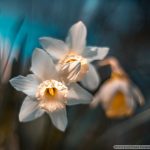
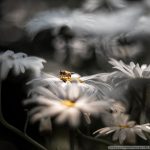



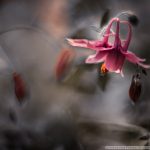
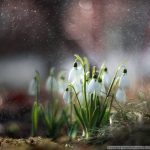




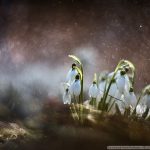
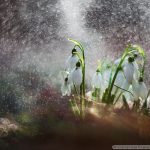
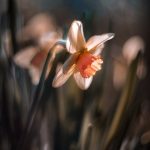
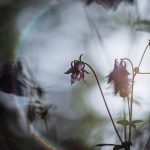
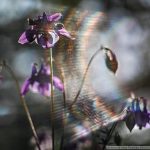

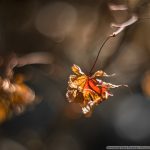
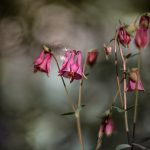
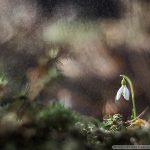

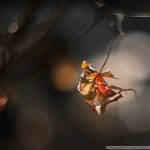
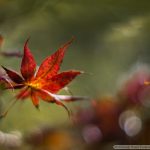


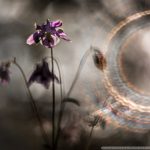

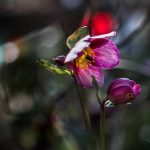









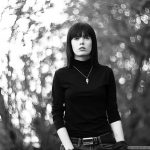


“In my vote for the best Soviet portrait lens, the Helios 40-2 is the undisputed leader, with a huge lead. The second place is held by the most massive fixed-telephoto camera Jupiter-37A, and the third place is closed by the disgracefully sharp Kalainar-5H ”…. Edit the article. Your survey actually has a different placement.
The article was written 4,5 years ago; It’s clear that now the arrangement is different.
The arrangement among the Soviet portrait painters is different? There are new Soviet portrait painters?
USSR - Alive!
And the CPSU-PZHIV.
The arrangement among the preferences of readers has changed. Obviously.
Is there any difference or feature by years of release?
I saw silver, (67-70gg) and black in a bag of brown leather, 71-78gg and in a tube up to 89 years.
Silver ones are considered better, but the condition of those sold on the secondary market is, as a rule, already poor.
After looking through examples of photos - namely, leaves and other bushes - even such banal photos look very boring and low-quality with this lens.
Nowadays they want about 7 thousand hryvnyas for it - that's almost 300 dollars. Add 100-150 dollars and you can buy a Zeiss 85 1.4 Planar, which is already very sharp at 1.4, and this objekiv is suitable for any tasks, and Helios 40 - play around for a week or two and put it up for sale.
Alien about our lens. There are also interesting comments. Helios 40-2 85mm f / 1.5 lens impression https://youtu.be/dDe1_-XS3gc
maybe it will amuse you ... our calm and boring troll ... where does the fun? we are talking about BOK! ... what he is famous for, why everyone buys him ... and in general, in principle, we are talking about .... (I smile with these critics ...)
but not so boring. just if the predisposition is to be considered the standard of reportage quality, then the pictures themselves resembling watercolors will be perceived as porridge ... it is a matter of perception.
Yes, and yet, the contrast failure in my specimen is simply catastrophic in the open. BUT! just twisting the contrast in the editor (I didn’t tweak anything with the improver) and we get very good result.
Here you can see a comparison with Biotar, the analogue of which is this Helios: http://www.deep-life.ru/test-12/index.htm And when you look, do not forget about the difference in cost.
There is also such a miracle ... Samyang 85mm T1.5 AS IF UMC VDSLR II
My favorite lens is Helios 40-2, the portrait was shot spontaneously, outdoors, handheld, without a flash:
A really very interesting lens, but the price for it is completely unjustified. I was interested in the lens, went to the OLH and was amazed that they ask for it on average 7-8 thousand hryvnia, and the record price is about 10 thousand. Really? for this Soviet optics, which is already a hundred years old at lunchtime ?! when it is possible to buy analogues of higher quality, “fresh” in terms of the year of production, adapted to work with modern technology.
IMHO, people went nuts. even for 2-3 thousand - I would have bought it. but for 10 ?! lol what else to say.
For this money, you can buy an autofocus analogue 85 \ 1.8
So buy it.
Who's stopping you?
Helios, etc. junk is taken by those who are already full of AF-glasses, how perfect, just as faceless.
You can get reskast to the state of diarrhea with anything, and the helios drawing (yes, together with undercontrast, manual focusing, hares in contrast, etc.) - only with helios.
+
“… You can grow to a state of diarrhea with anything”. Strong, very strong))
In some cases, it is better to remain silent - didn’t your mother teach?))))
What is this hybrid?
Confused by the inscription on the title ring in Latin letters HELIOS-40 and the number starting with one. Pearl-black anodized case with a chamfer processed after painting on the focusing ring. Thread for a 66mm filter, sort of. Enlightenment is purple. But at first glance it seems that this is the usual 40-2.
Collected from several lenses?
Demand creates supply. I will not pay $ 250-300 for this lens, unless I will collect the collection and from this point of view, not to shoot. But if they are put up for sale at such prices, then someone is buying them at such prices. It even happens that the matter is not in the quality of the lens, but in the inspiration that it exerts on its owner. This is how to look at women who inspired famous artists, many will say, and what is in them, and what is in them is that thanks to them, those artists created their masterpieces. If on the site of those muses of the beauty queen, nothing masterful would have happened. It would be just a beautiful picture, qualitatively created, but no more.
Objective Helios-40-2 1.5 / 85
Tell me, please, what kind of adapter do you need to buy an adapter for Nikon D7100 cameras: without a lens and a chip, with a lens without a chip here or with a chip without a lens? They say that you need to take with a lens so that there is infinity. Do you need a chip?
A chip is not needed for the D7100. A lens will degrade image quality. Hand over to the master, let her tail tail under Nikon, so it will be as rational as possible.
And if you buy an adapter without a chip and without a lens, will it be the same solution as carrying the tail?
They just told me that an adapter is needed with a lens so that there is an infinity awn. This is true? Thanks for the answer.
Getting infinity is possible in three ways (depending on the model of the lens):
1. An adapter with a lens, but image quality is lost
2. Disassembly and removal (or replacement with a thin wire) of the adjusting rings (I practically achieved infinity on Helios-44-2 - for my needs the maximum focusing distance of 7m was enough). Image quality is not affected.
3. Shank regrinding. Image quality does not suffer.
The chip is needed to facilitate focusing, it does not affect infinity in any way.
It turns out, if you drag the shank for a better image without a lens, then autofocus is no longer possible?
Autofocusing is not possible with both the lens and the chip. This is a manual lens
Could you tell me who could have “sharpened the shank” in Kiev?
Mr. Google. VK has a lot of co, where the owners are turners. Reshoot with pleasure.
Although this is not great, IMHO. but why not for the sake of experiment.
Usually not attached to the place. You can also send by mail
There is still a 4th method. Use Pentax photographic equipment. And nothing to sharpen, no need to chip.
Yes, Pentax is a cool technique, like the G-40
In the year 1976.
Autocorrect on the phone, I wanted to write "regrind"
Tell me. Here in the comments it is advised not to use an adapter with glass, but to replace the lens shank to improve the picture. But at the same time, I would like for the focus signal to work. Is that possible?))
Judging by the issue we are talking about nikon. With them, the green dot will burn with and without a lens. But there is no autofocus and cannot be, this is the question above.
This is only possible with Pentax cameras.
When set to Nikon, what is the maximum focus distance?
can’t you make portraits in height?
85mm? Yes, you can, you just have to squeeze and move far. Pinched = killed the drawing, at 8 all the glasses are the same. Send away = did not catch the light, just far and not very visible ...
Why so tormented by doubts. It’s easier to buy another fix
For a long time I want to try it on nikon, there is a crop, and FF
There is only one question - is it worth trying Helios-40-2N or is the quality necessarily worse?
If you don't want an adapter with a lens, if you use an adapter with a chip, then to what distance will the focusing be at least approximately?
giving old remake on nikon is not cheap
Good day. I got a Helios 40T lens for free. I want to put on the Central Control Commission redoing the shank. Does anyone know what working distance on this lens? On my specimen, the shank diameter is just huge! I don’t want to sharpen / saw by eye, there is almost no information on the Internet, except for one person who redid this lens by eye. Thanks!
http://spforum.mflenses.com/helios-40t-couple-t78183.html - did they ask? Uncle sold them, writes that they are from the camera of the KT-27 television camera, but there is practically nothing on it either. Maybe it will lead to the one who adapted for M42.
Who knows, there is a difference in the picture of Helios 40-2 of the old model and the new production from the zenith ???
As far as I know, before putting the G-40-2 on the conveyor, KMZ did not optimize the optical design
G-40, keeping it 1: 1. Then, how to explain the difference in resolution given everywhere: G-40 32/16 and
G-40-2 37/17 lin / mm? Everything is very simple: the methodology for determining the resolution of the lens in the quality control system of the plant has changed somewhat. According to the requirements of the technical conditions of that time, it is carried out on film
45-65 GOST. But somewhere at the end of the 60s, a new GOST was introduced for the Photo series film films.
Compared with the old GOST, they have about 10-15% increased resolution, which generally corresponds to the figures above. I can not categorically say, but strongly suspect that
the highest quality lenses have always been exported, so you need to look for instances with the inscription
Helios 40-2. The rest of consumer goods went to the domestic market.
QUOTE: To achieve good image quality with the right focus point and the right composition - you will need to try hard.
I AM KANESHNA, I EXCUSE WILDLY, BUT HANDS FROM WHERE TO HAVE IN ORDER NOT TO ACHIEVE RESULTS? THIS IS NOT DIFFICULT! IF YOU CANNOT WORK WITH THE MANUAL OPTICS - BUY A SOAP !!! There is nothing difficult. Open the hole and move the body! EVERYTHING!
You fully voice the quote, starting with "There is a myth that with the help of Helios-40 anyone can take a gorgeous portrait."
I bought it. And somehow not very much. The situation is as follows. In passive: Nikonovody, the first thing you will encounter is the need to saw through on Nikon, It is not enough to simply remove the adjustment ring, you have to carry it to the turner. Second, 1.5 soap and software. From edge to center. Completely, everywhere. the portrait is essentially shot from 2.0. Something in common from 5.6 to 8. Third. It is better to shoot through LiveView and with a tripod. Fourth, processing. It is always. Otherwise, about nothing like a whale (okay, better, but there is no magic). Fifth, if you want bokeh twisted - look for the background. In general, the lens is very picky about the hands. Take the sixth only on FF. You don’t need to take it for a crop, you don’t get from it what you saw on the net, you won’t get anything but disappointment ... Seventh. This is a very very highly specialized lens for certain conditions and certain shooting. It does not replace the standard portrait lens, it complements it. In the asset. If everything coincided as it should, if everything happened correctly, then that's when yes, magic!
In general, at some point I had the opinion that this is a very expensive filter with the effect of one-piece with the lens. That is, not to become his main portrait portrait.
what a fellow you are! All explained in detail and laid out on the shelves. Thanks for the work!
They bought this lens for me when I was a schoolboy. In an era of scarcity, my father could not get a modern, black one and took a white, 66 year old. I didn’t shoot anything intelligible to them. When I switched to Nikon, I first used 85 1.8 (not Ai), and then completely abandoned fix 85, switching to 105/135 mm. Actually, 85 mm is needed only to shoot a person at full height. Or medium shots, in limited space. But Helios is not really suitable for this either: the resolution is terrible across the field. A goofy lens is just a toy. Really suitable only for Instagram photos in a square format (the soap field is cut off). The working range of apertures is from 4,0 to 8,0.
From the school bench did not understand the beauty of the lens? Well, it is necessary and true to have a rare gift not to see the obvious.
I AM NOT A PHOTOGRAPHER - and even then from the pictures I immediately see what the lens is good for))))
The funniest thing. this is when they write about portraits that there is not enough sharpness.
Have you ever taken portraits? And not for wedding customers, but just to create a full-fledged image.
Plus, catching up - my helios still with M39 threads gives a completely normal picture with a lens.
Plus - 85 mm is not intended for full-length portraits, all other things being equal. This is already a transition to larger plans. Although growth is not prohibited, but this is not his niche, if this is very exaggerated
Um, 85 is not intended for growth?) Who told you such nonsense?) Or did you think of it yourself?
A curious thing is this Helios-40 (-2). 50 years ago I already had the first edition of the G-40 on the M39. The first test photographs on film killed me on the spot. It was a nightmare. The lens immediately ended up in the farthest cabinet and never One day I put things in order and accidentally re-opened this miracle. Nearby was my nephew. He interested him and I immediately did
a gift to him, rejoicing that he had got rid of the trash. I think that in a month or two the tribe pushed him for 1-2 bottles of vodka. But new digital times came. In the internet, strange, unlike anything romantic pictures taken on G began to come across -40 (-2). Now I’m not so categorical and I recognize the G-40's right to life, but it’s a very picky lens. How do we usually choose the optics? According to the plot, the G-40 is not like that; it puts the photographer’s work upside down. To get something from him, you need to do the opposite: pick a story to the lens. Something similar has happened before, for example, a monocle, a pinhole. Personally, I have such a skill, alas, has not developed.
Great lens for portraiture. Legend of the Soviet photo business. It’s better to use it on a full matrix, but on a regular SLR, wonderful photos are obtained. I bought in Schwab.
Hello, please tell me, did you buy a new Helios 40 2 or Soviet model year? I read here that the Soviet options are removed better otherwise. Is this really true or a myth? Thank you so much in advance
We must look at specific instances. There are new G-40-2 with chips inside and a clumsy assembly, they will be worse than the old 40-2, most likely. But in general, the new one has multi-layer coating - this is a big plus for a lens of this type.
It is not at all clear what Sergei Elizarov is comparing. Either Helios 40-2 with Biotar-75, or Helios 40 ?! Along the way, he himself did not hold the latter in his hands.